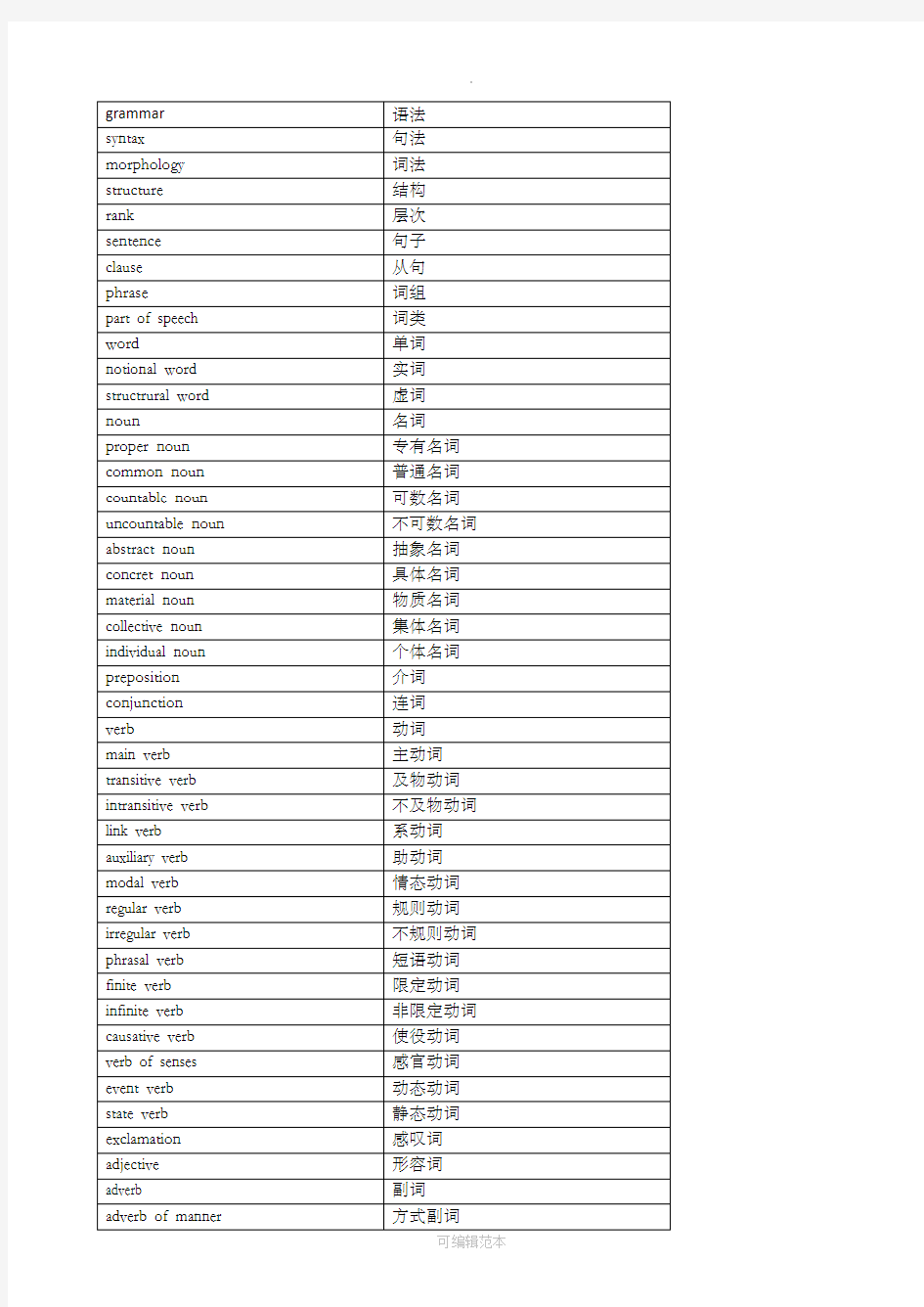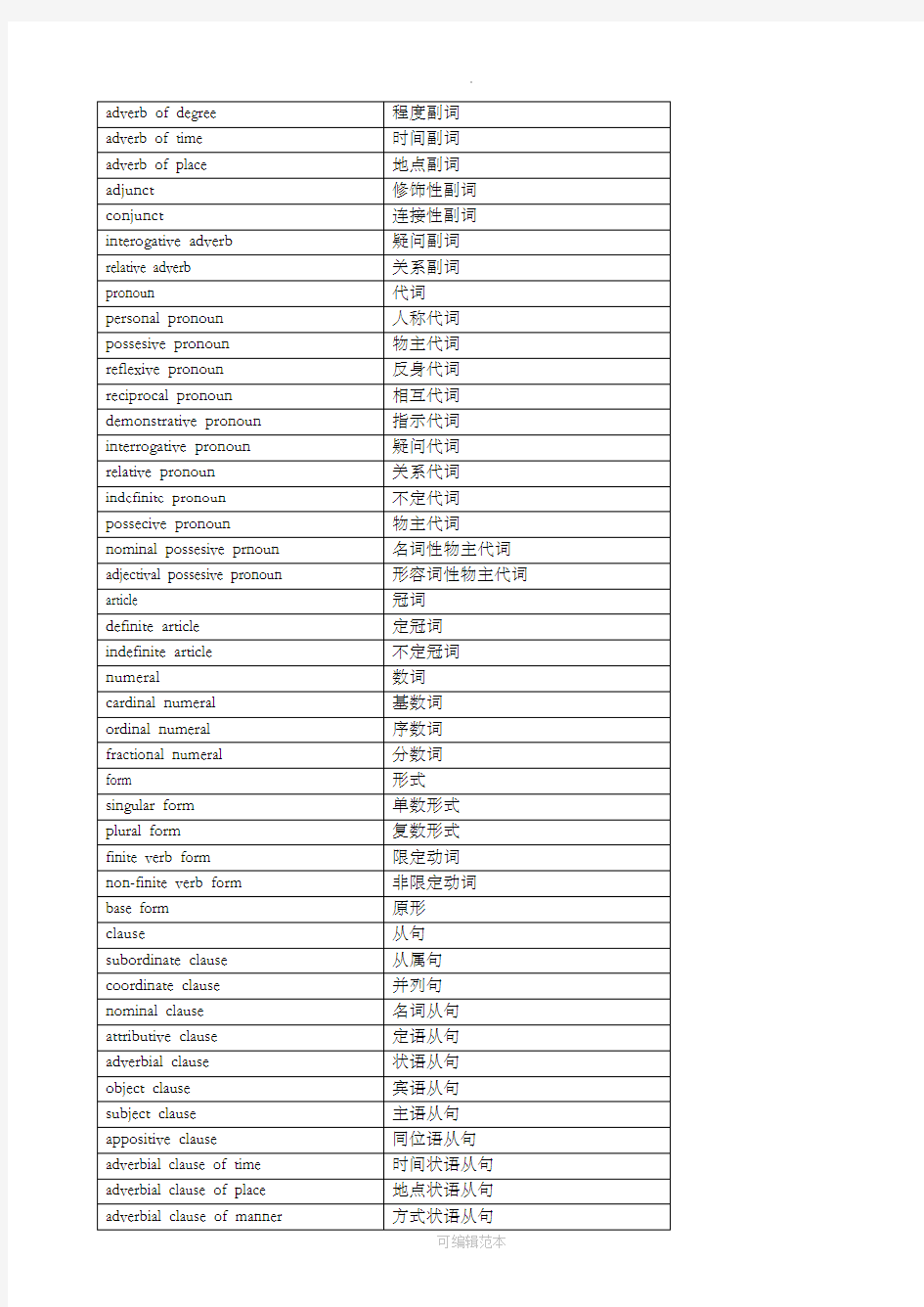英语语法专有名词中英对应名称


初中英语语法大全——名词
初中英语语法大全——名词 一、名词概述 1.名词的定义 名词是表示人、事物、地点、现象及其他抽象概念等名称的词。英语中的名词有可数名词和不可数名词之分;有其所有格形式;在句子中通常做主语、宾语、宾语补足语、表语、定语等。 2.名词的分类 名词分为专有名词和普通名词两类。普通名词又分为个体名词、集体名词、物质名词和抽象名词。个体名词与集体名词多数是可数名词,而物质名词与抽象名词多数是不可数名词。
二、名词的数 名词按照其可数性可以分为可数名词和不可数名词。可数名词是指可以直接计算数目的名词。个体名词和集体名词多数是可数名词;不可数名词是指无法直接用数目计算的词。物质名词和抽象名词多数是不可数名词。 1.可数名词的数 在英语中,可以直接用数字进行计算的名词是可数名词,不能直接用数字进行计算的名词是不可数名词。通常个体名词和集体名词可以用数目来计算,视为可数名词;物质名词和抽象名词往往指泛指的物质或者抽象的概念,不能用具体的数字来表示,视为不可数名词。专有名词往往只指一个人或物,因此没有必要再用具体的数字来修饰,一般也视为不可数名词。
eg: I was having dinner at a restaurant. eg: The two children are playing table tennis in the school. eg: Mr.Black gave us some advice on how to learn English well. eg: Paris is the capital of France. ①规则复数变化形式 可数名词在表示两个或两个以上的概念时需要用复数形式。可数名词单数形式变成复数形式的一般规则如下表:
英语语法大全
《英语语法大全》 1.名词 名词可以分为专有名词(Proper Nouns)和普通名词(Common Nouns). 专有名词是某个(些)人,地方,机构等专有的名称,如Beijing,China等。 普通名词是一类人或东西或是一个抽象概念的名词,如:book,sadness等,普通名词又可分为下面四类: 1)个体名词(Individual Nouns):表示某类人或东西中的个体,如:gun。 2)集体名词(Collective Nouns):表示若干个个体组成的集合体,如:family。 3)物质名词(Material Nouns):表示无法分为个体的实物,如:air。 4)抽象名词(Abstract Nouns):表示动作、状态、品质、感情等抽象概念,如:work。 个体名词和集体名词可以用数目来计算,称为可数名词(Countable Nouns) 物质名词和抽象名词一般无法用数目计算,称为不可数名词(Uncountable Nouns)。 归纳一下,名词的分类可以下图表示:
1.2其它名词复数的规则变化 1)以y结尾的专有名词,或元音字母+y结尾的名词变复数时,直接加s变复数: 如:two Marys the Henrys monkey---monkeys holiday---holidays 比较:层楼:storey---storeys story---stories 2)以o结尾的名词,变复数时: a.加s,如:photo---photos piano---pianos radio---radios zoo---zoos; b.加es,如:potato--potatoes tomato--tomatoes c.均可,如:zero---zeros/zeroes 3)以f或fe结尾的名词变复数时: a.加s,如:belief---beliefs roof---roofs safe---safes gulf---gulfs; b.去f,fe加ves,如:half---halves knife---knives leaf---leaves wolf---wolves wife---wives life---lives thief---thieves; c.均可,如:handkerchief:
(完整版)英语语法专业术语
英语语法专业术语 语法grammar 句法syntax 词法morphology 结构structure 层次rank 句子sentence 从句clause 词组phrase 词类part of speech 单词word 实词notional word 虚词structural word 名词noun 专有名词proper noun 普通名词common noun 可数名词countable noun 不可数名词uncountable no 抽象名词abstract noun 具体名词concrete noun 物质名词material noun 集体名词collective noun 个体名词individual noun 介词preposition 连词conjunction 动词verb 主动词main verb 及物动词transitive verb 不及物动词intransitive verb 系动词link verb 助动词auxiliary verb 情态动词modal verb 规则动词regular verb 不规则动词irregular verb 短语动词phrasal verb 限定动词finite verb 非限定动词infinite verb 使役动词causative verb 感官动词verb of senses
动态动词event verb 静态动词state verb 感叹词exclamation 形容词adjective 副词adverb 方式副词adverb of manner 程度副词adverb of degree 时间副词adverb of time 地点副词adverb of place 修饰性副词adjunct 连接性副词conjunct 疑问副词interrogative adverb 关系副词relative adverb 代词pronoun 人称代词personal pronoun 物主代词possessive pronoun 反身代词reflexive pronoun 相互代词reciprocal pronoun 指示代词demonstrative pronoun 疑问代词interrogative pronoun 关系代词relative pronoun 不定代词indefinite 物主代词possessive pronoun 名词性物主代词nominal possessive 形容词性物主代词adjectival possessive pronoun 冠词article 定冠词definite article 不定冠词indefinite article 数词numeral 基数词cardinal numeral 序数词ordinal numeral 分数词fractional numeral 形式form 单数形式singular form 复数形式plural form 限定动词finite verb form 非限定动词non-finite verb form
英语语法术语中英文对照
词性 part of speech16)动态动词 event verb 17)静态动词 stage verb1.名词 noun 3.形容词 adjective proper noun1)专有名词 4.2)普通名词 common noun副词 adverb 1)方式副词3)可数名词 countable noun adverb of manner 2)程度副词 adverb of degree4)不可数名词 uncountable noun3)时间副词 abstract noun adverb of time5)抽象名词4)具体名词 concrete noun地点副词 adverb of place6)5)修饰性副词7)物质名词 material noun adjunct 6)连接性副词8)集体名词 collective nounconjunct 7)疑问副词 interrogative adverb individual noun9)个体名词 8)关系副词 relative adverb动词2. verb 5.代词 pronoun transitive verb1)及物动词 1)人称代词2)不及物动词 intransitive verb personal pronoun 2)物主代词 finite verb form3)限定动词 possessive pronoun 3)非限定动词4) non-finite verb form名词性物主代词 nominal possessive pronoun main verb5)主动词 4)形容词性物主代系动词6) link verb 词 adjectival possessive pronoun7)助动词 auxiliary verb5)情态动词8) modal verb反身代词reflexive pronoun 6)指示代词 regular verb规则动词9) demonstrative pronoun 7)疑问代词 interrogative pronoun不规则动词10) irregular verb8) phrasal verb短语动词关系代词 relative pronoun11)9) finite verb限定动词不定代词 indefinite pronoun12)6.13) infinite verb非限定动词冠词 article 1)14)causative verb使役动词定冠词 definite article indefinite article不定冠词2)verb of senses感官动词15). 7.数词 numeral8.介词 preposition 9.基数词 cardinal numeral连词 conjunction1)10.感叹词 exclamation2)序数词ordinal numeral number/case/gender格//性一、数3.性 gender1.数 number 1)阴性 feminine1)单数形式 singular form2)2)阳性 masculine复数形式 plural form3)中性neuter3)规则形式 regular form4)通性 common irregular form4)不规则形式 4.人称 person格2. case 1)第一人称 first person1)普通格 common case 2)2)所有格 possessive case第二人称 second person 3)第三人称 third person nominative case3)主格宾格4) objective case二、句子成分 members of sentences5)同源宾语 cognate object主语1. subject 5. predicate谓语定语 attribute 2. 6.3.状语表语 predicative adverbial 7.4.宾语同位语 appositive object 8.双宾语1)补语 dual object complement 1)2)主语补足语 direct object直接宾语 subject complement 2)3)宾语补足语 object complement间接宾语 indirect object4)复合宾语 complex object
英语语法专业术语表达
英语语法专业术语表达 英语语法语语语语表达 1. Morphology 语法 2,Notional Words 语语语3, Form Words 虚语 4,Parts of Speech 语语 5,The Noun 名语 6,The Pronoun 代语 7,The Numeral 数语 8,The Verb 语语 9,The Adjective 形容语 10. The Adverb 副语 11. The Article 冠语 12. The Preposition 介语 13. The conjunction 语语 14. The Interjection 感语语15. The Particle 小品语 16. Word Building 构语法17. Conversion 语化 18. Derivation 派生 19. Composition 合成 20. Prefix 前语 21. Suffix 后语 22. Compound Words 合成语23. Classification of Nouns 名语的分语
24. Common Nouns 普通名语 25. Proper Nouns 语有名语26. Countable Nouns 可名语数27. Uncountable Nouns 不可名语数28. The Singular Form 语形式数29. The Plural Form 语形式数 30. Individual Nouns个体名语31. Collective Nouns集名语体32. Material Nouns物语名语33. Abstract Nouns抽象名语34. The Common Case普通格35. The Possessive Case所有格36, Personal Pronouns 人代语称37. Possessive Pronouns物主代语38. Self Pronouns反身代语39. Demonstrative Pronouns指示代语40. Interrogative Pronouns疑语代语不意达41. Conjunctive Pronouns语接代语42. Relative Pronouns语系代语43. Indefinite Pronouns不定代语44. Reciprocal Pronouns相互代语45. The Subjective Case主格46. The Objective Case语格47. Cardinal Numerals基语数48. Ordinal Numerals 序语数49. Fractional Numerals分语数50,Notional Verbs语意语语 51. Link Verbs语系语语 52. Auxiliary Verbs助语语 53. Modal Verbs情语语语 54. Transitive Verbs及物语语 55. Intransitive Verbs不及物语语56. Regular Verbs语语语语 57. Irregular Verbs不语语语语 58. Person人称 59. Number数 60. Tense语语 61. Voice语语 62. Mood语气
英语语法术语汇总(中英对照)
[2] 英语语法术语汇总(中英对照) 英语语法术语(中英对照) 语法 grammar 句法 syntax 词法 morphology 句子 sentence 从句 clause 词组 phrase 词类 part of speech 单词 word 实词 notional word 虚词 structural word 单纯词simple word 派生词derivative 复合词compound 词性 part of speech 名词 noun 专有名词proper noun 普通名词common noun 可数名词count able noun 不可数名词 uncount able noun 抽象名词 abst ract noun
具体名词concret noun 物质名词 mat erial noun 集体名词collective noun 个体名词individual noun 介词 preposition 连词 conjunction 动词 verb 主动词main verb 及物动词transitive verb 不及物动词intransitive verb 系动词link verb 助动词auxiliary verb 情态动词 modal verb 规则动词regular verb 不规则动词irregular verb 短语动词phrasal verb 限定动词finite verb 非限定动词infinit e verb 使役动词causative verb 感官动词 verb of senses 动态动词 event verb 静态动词st ate verb 感叹词exclamation 形容词adjective
初中英语语法名词篇
初中中考英语语法 (名词篇) 语法总述: 名词篇: 名词的种类:英语名词可分专有名词和普通名词两大类: 1、专有名词是个别的人、地、物、团体、机构等的专用名称。 专有名词中实词的第一个字母要大写。如:Jilin, Tom, China, (1)零冠词,如Yale University,Beijing Railway Station,是由专有名词+普通名词组成,往往为并列关系。 (2)定冠词,如the United States,the Great Wall,由形容词+普通名词组成。 (3) 姓氏名如果采用复数形式,则表示该姓氏一家人(复数含义),如:the Greens( 格林一家人)。 2、普通名词是许多人或事物的共有名称。 普通名词又可进一步分为四类 1) 个体名称: 表示单个的人和事物。 house 马car 汽车room 房间apple 苹果fun 风扇picture 照片 2) 集体名称: 表示一群人或一些事物的名称。 people 人们 family 家庭 army 军队government 政府 group 集团 3) 物质名词:表示物质或不具备确定形状和大小的个体的物质。 fire 火 steel 钢air 空气water 水milk 牛奶 4)抽象名词:表示动作,状态,品质或其他抽象概念。
labour 劳动health 健康life 生活friendship友情patience耐力 3. 普通名词又分为可数名词和不可数名词。 可数名词是可以用简单的数词进行计数的名词,如: box, child, orange; 不可数名词是不可以用简单的数词进行计数的名词。如:water, news, oil, population, information . 4、英语可数名词的单复数:英语可数名词有单数和复数两种形式。 1. 规则名词的复数形式:
教师资格证英语语法专业术语
语法grammar 句法syntax 结构structure 句子sentence 从句clause 词组phrase 词类part of speech 单词word 实词notional word 虚词structural word 单纯词simple word 派生词derivative 复合词compound 词性part of speech 名词noun 专有名词proper noun 普通名词common noun 可数名词countable noun 不可数名词uncountable noun 抽象名词abstract noun 具体名词concret noun 物质名词material noun 集体名词collective noun 个体名词individual noun 介词preposition 连词conjunction 动词verb 及物动词transitive verb 不及物动词intransitive verb 系动词link verb 助动词auxiliary verb 情态动词modal verb 规则动词regular verb 不规则动词irregular verb 限定动词finite verb 非限定动词infinite verb 使役动词causative verb 感官动词verb of senses 感叹词exclamation 形容词adjective 副词adverb 方式副词adverb of manner 程度副词adverb of degree 时间副词adverb of time 地点副词adverb of place 关系副词relative adverb 代词pronoun 人称代词personal pronoun 物主代词possessive pronoun 反身代词reflexive pronoun 指示代词demonstrative pronoun 疑问代词interrogative pronoun 关系代词relative pronoun 不定代词indefinite pronoun 物主代词possessive pronoun 名词性物主代词nominal possessive pronoun 形容词性物主代词adjectival possessive pronoun 冠词article 定冠词definite article 不定冠词indefinite article 形式form 单数形式singular form 复数形式plural form 原形base form 从句clause 从属句subordinate clause 并列句coordinate clause 名词从句nominal clause 定语从句attributive clause 状语从句adverbial clause 宾语从句object clause 主语从句subject clause 同位语从句appositive clause 时间状语从句adverbial clause of time 地点状语从句adverbial clause of place 方式状语从句adverbial clause of manner 让步状语从句adverbial clause of concession 原因状语从句adverbial clause of cause 结果状语从句adverbial clause of result 目的状语从句adverbial clause of purpose 条件状语从句adverbial clause of condition 句子sentence 简单句simple sentence 并列句compound sentence 复合句complex sentence 并列复合句compound complex sentence 陈述句declarative sentence
常用英语语法术语表 中英
常用英语语法术语表达 语法grammar 句法syntax 词法morphology 结构structure 层次rank 句子sentence 从句clause 词组phrase 词类partofspeech 单词word 实词notionalword 虚词structuralword 单纯词simpleword 派生词derivative 复合词compound 词性part?of?speech 名词?noun? 专有名词?proper?noun? 普通名词?common?noun? 可数名词?countable?noun? 不可数名词?uncountable?noun? 抽象名词?abstract?noun? 具体名词?concrete?noun? 物质名词?material?noun? 集体名词?collective?noun? 个体名词?individual?noun? 介词?preposition? 连词?conjunction? 动词?verb? 主动词?main?verb? 及物动词?transitive?verb? 不及物动词?intransitive?verb? 系动词?link?verb? 助动词?auxiliary?verb? 情态动词?modal?verb? 规则动词?regular?verb? 不规则动词?irregular?verb? 短语动词?phrasal?verb? 限定动词?finite?verb? 非限定动词?infinite?verb? 使役动词?causative?verb
感官动词?verb?of?senses? 动态动词dynamic verb? 静态动词?state?verb? 感叹词?exclamation? 形容词?adjective 副词?adverb? 方式副词?adverb?of?manner? 程度副词?adverb?of?degree? 时间副词?adverb?of?time? 地点副词?adverb?of?place? 修饰性副词adverb of?adjunct? 连接性副词?adverb of conjunct? 疑问副词?interrogative?adverb? 关系副词?relative?adverb 代词?pronoun? 人称代词?personal?pronoun? 物主代词?possessive?pronoun? 反身代词?reflexive?pronoun? 相互代词?reciprocal?pronoun? 指示代词?demonstrative?pronoun? 疑问代词?interrogative?pronoun? 关系代词?relative?pronoun? 不定代词?indefinite?pronoun? 名词性物主代词?nominal?possessive?pronoun? 形容词性物主代词?adjectival?possessive?pronoun? 冠词?article? 定冠词?definite?article 不定冠词?indefinite?article 数词?numeral? 基数词?cardinal?numeral? 序数词?ordinal?numeral? 分数词?fractional?numeral? 形式?form? 单数形式?singular?form? 复数形式?plural?form? 限定动词?finite?verb?form? 非限定动词?non-finite?verb?form? 原形?base?form?
英语语法专有名词中英文对照说法
英语语法专有名词中英文对照说法 最近有同学反应,上外教课时,有些语法问题要和老师沟通,却不知道一些语法专有名词的英文怎么说,于是,只能用一大串英语来描述一个专有名词。例如,同学想问形容词的用法时,不会“形容词” 的英语说法,只好把问题这么描述::“What are the rules of the words that are used to describe a person or thing?” 其实,the words that are used to describe a person or thing 指的就是形容词, 形容词的英文说法是“adjective”. 有鉴于此,现在把英文语法的专有名词说法,整理如下,同学花个几分钟的时间把他们记起来,下次再想问外教语法问题时,就不用那么麻烦啰! 中文英文全称及缩写中文英文全称及缩写 名词Noun (n.) 时态Tense 代词Pronoun (pron.) 一般式Simple tense 形容词Adjective (adj./a.) 进行式Progressive tense 动词Verb (v.) 完成式Perfect tense 数词Numeral (num.) 完成进行式Perfect Progressive tense 副词Adverb (adv./ad.) 现在时Present tense 冠词Article (atr.) 过去时Past tense 介词Preposition (prep.) 将来时Future tense 连词Conjunction (conj.) 过去将来时Past future tense 感叹词Interjection (interj.) 标点符号Punctuation Mark 词法Morphology 句号(.) Period (full stop) 句法Syntax 问号(?) Question mark 句子成分Members of the 惊叹号(!) Exclamation mark Sentence 主语Subject 逗号(,) Comma 谓语Predicate 分号(;) Semicolon 表语Predicative 冒号(:) Colon
英语语法专业术语表达
active voice 主动语态,passive voice被动语态, absolute construction独立结构, adjective 形容词,adverd 副词,noun名词, verb动词, artical冠词, determiner限定词,quantifier量词,numeral数词, subject主语, object宾语,adverbial状语,attributive定语,complement补语,predicative表语,appositive同位语,infinitive不定式, -ing participle-ing分词, -Ed participle -ed分词,finite clause 限定从属分句,non-finitive clause非限定分句,inversion倒装,adverbial clause状语从句,subject clause主语从句,relative clause/attributive clause定语(关系)从句,从句也可以用clause as subject/object/来表示主语从句、宾语从句 时态:tense语态:voice单数:singular form复数:plural form 主谓一致:agreement of subject and verb 定语从句:attributive clause 名词性从句: noun clause 状语从句:adverbial clause 虚拟语气:subjunctive mood 冠词:article代词:pronoun形容词和副词:adjective & adverb 动词和动词词组:verbs & verb phrase 非谓语动词:Non-Predicate Verbs / Non-Finite verbs
英语语法常用词汇
English grammar terms often used 英语语法常用词语1.Parts of speech 词类 noun 名词pronoun 代词numeral 数词adjective 形容词verb 动词adverb副词article 冠词preposition介词conjunction连词interjection感叹词particle 小品词 2. Word building 构词法 conversion 转化derivation 派生affixation词缀法prefix前缀suffix后缀compound words 合成词 3.Classification of nouns 名词的分类 common nouns普通名词proper nouns 专有名词 individual nouns个体名词collective nouns 集合名词 material nouns 物质名词abstract nouns 抽象名词 countable nouns 可数名词uncountable nouns不可数名词 the singular form 单数形式the plural form 复数形式 the common case 普通格the possessive case 所有格 the subjective case 主格the objective case 宾格 person 人称third person singular 第三人称单数 4. Classification of pronouns 代词的分类 personal pronouns 人称代词possessive pronouns 物主代词 self pronouns 反身代词demonstrative pronouns 指示代词 interrogative pronouns 疑问代词conjunctive pronouns 连接代词 relative pronouns 关系代词reciprocal pronouns 相互代词 indefinite pronouns 不定代词 5.数词、形容词、冠词 cardinal numerals 基数词ordinal numerals 序数词 fractional numerals 分数词the comparative degree 比较级 the superlative degree 最高级The definite article 定冠词 the indefinite article 不定冠词 6.Classification of verbs 动词的分类 national verbs 实义动词link-verbs系动词 auxiliary verbs助动词modal verbs 情态动词 transitive verbs 及物动词intransitive verbs 不及物动词 regular verbs 规则动词irregular verbs 不规则动词 the present forms 现在式the past forms 过去式 the participle 分词the present participle现在分词 the past participle 过去分词the infinitive 不定式 the gerund 动名词bare infinitive 不带to的不定式
初中英语语法大全:名词
初中英语语法大全:名词 一名词的定义:表示人、事物或抽象概念的名称的词。 二名词的分类: 名词可以分为专有名词(Proper Nouns)和普通名词 (Common Nouns),专有名词是某个(些)人,地方,机构等专有的名称,如Beijing,China等。普通名词是一类人或东西或是一个抽象概念的名词,如:book,sadness等。普通名词又可分为下面四类: 1)个体名词(Individual Nouns):表示某类人或东西中的个体,如:gun。 2)集体名词(Collective Nouns):表示若干个个体组成的集合体,如:family。 3)物质名词(Material Nouns):表示无法分为个体的实物,如:air。 4)抽象名词(Abstract Nouns):表示动作、状态、品质、感情等抽象概念,如: work。 … 注意专有名词一般第一个字母要大写。专有名词前一般不加冠词。 名词的种类 注意物质名词与抽象名词一般无法用数目来计算,称为不可数名词。不可数名词前不能加冠词a或an来表示量。 (三)名词的数 1.可数名词有单数和复数两种形式: 1.单数 英语中,如果我们要表示一本书、一只鸟、一棵树等概念时,要用名词的单数形式,表示名词的单数,要在名词前加冠词a或an。 This is a desk . 这是一张书桌。
[ There is an orange on the table . 桌上有一个橘子。 an orange 一个橘子an new orange (×)→a new orange (○) 一个新橘子 a desk a old desk (×)→an old desk (○)一张旧课桌 a和an的使用区别 a加在以辅音开头的名词前,如a book,a pen。 an加在以元音开头的名词前,如an egg,an apple。 注意 ! 有时a,an后面紧接的不是单数名词,而是a (an) +形容词+单数名词的形式。 这时判断用a还是an来表示“一个”的概念时,要看形容词开头字母的发音,而不 是看名词。 2.复数 英语中,如果要表示两本书、三个学生、四把椅子这些两个或两个以上的概念时,要用名词的复数形式,名词的复数形式是在单数名词后加上词尾-s或-es构成的。 变复数时情况如下: (1)一般情况下,在词尾加s. eg.book——books,dog——dogs,pen——pens,boy——boys 以轻辅音结尾的名词后的s的读音为[s],以浊辅音和元音结尾名词后的s读音为〔z〕。 (2)以s,x,ch,sh结尾的词名词变复数时,要在词尾加es.
英语中的专有名词_名词 英语语法.doc
英语中的专有名词_名词 专有名词的定义: 专有名词表示特定的人名、地名或组织机构的名称,专有名词一般具有独一性。除个别外,专有名词通常没有复数形式。例如: 1. 人名、地名:Jenny 珍妮Smith 史密斯China 中国Asia 亚洲the Great Wall 长城London 伦敦 2. 组织机构、时间、书籍报刊等的名称:the United Nations 联合国Bank of China 中国银行May 五月份Sunday 星期天Time《时代》周刊the Guardian《卫报》 3. 家庭关系名称、个人头衔:Mum 妈妈Grandpa 爷爷Doctor Black 布莱克大夫Captain Grey 格雷船长Mr. Hopkins 霍普金斯先生Miss White 怀特小姐 专有名词的注意事项: 1. 因为专有名词具有专有独一性,所以一般情况下,专有名词的第一个字母要大写,不能在专有名词的前面加上不定冠词a,也不能在专有名词词尾加上表示复数形式的-s。如: Beijing is the capital of China. 北京是中国的首都。 但是有时专有名词可以转化成为普通名词,转化后它就具有普通名词的特性了,即可以在其前面加上不定冠词a,在其词尾加上表示复数形式的-s。以下是专有名词转化成可数普通名词的例子:
A Mr Green called just now. 刚才有位格林先生打来电话。(此时a Mr Green = a man called Mr Green) I knew a John Lennon, but not the famous one. 我认识一个叫约翰莱农的人,但不是著名的那一位。英语中的专有名词 There are three Johns in this class. 这个班里有三个叫约翰的人。(此时three Johns = three persons called John) There are many Edisons in our country. 此句有两种不同的意思: 其一、我们国家有许多叫爱迪生的人。 其二、我们国家有许多像爱迪生一样的发明家。 2. 姓氏是专有名词,一般没有复数形式,而且也不能加定冠词the。但是,当姓氏的前面加定冠词the,在后面加上-s,表示一家人。如:the Smiths 史密斯一家人 The Blacks have moved house. 布莱克一家已经搬走了。 3. 有些专有名词表面上看是复数形式,但是在实际使用中谓语动词通常采用单数形式。例如: the United States 美国 The United Nations was organized in 1945. 联合国是1945年组建起来的。
常见英语语法速记
常见英语语法速记 一be得用法口诀! 我用am,您用are,is连着她,她,它; 单数名词用is,复数名词全用are。 变疑问,往前提,句末问号莫丢弃。 变否定,更容易,be后not莫忘记。 疑问否定任您变,句首大写莫迟疑。 二时间名词前所用介词得速记歌 年月周前要用in,日子前面却不行。 遇到几号要用on,上午下午又就是in。 要说某日上下午,用on换in才能行。 午夜黄昏须用at,黎明用它也不错。 at也用在明分前,说“差”可要用上to, 说“过”只可使用past,多说多练牢牢记,莫让岁月空蹉跎。 三记住f(e)结尾得名词复数 妻子持刀去宰狼,小偷吓得发了慌; 躲在架后保己命,半片树叶遮目光。 九个以f(e)结尾得名词。Wife(妻子)。Knife(刀子)、wolf(狼)、thief(小偷)、shelf(架子)、self(自己)、life(生命)、half(一半)、leaf(树叶) 这些名词以f(e)结尾变复数时,将f(e)变v再加es。还有以self结尾得反身代词复数用法也同样,如:myselfourselves、yourselfyourselves。 例外得有serf(农奴)、chief(首领)、belief(信仰)、safe(保险柜)、gulf(海湾),它们以直接加s变为复数形式,另外handkerchief可用两种复数形式:handkerchiefs或handkerchieves。四巧记48个国际音标 单元音共十二,四二六前中后。 双元音也好背,合口集中八个整。 辅音共计二十八,八对一清又七浊, 四个连对也包括。有气无声清辅音, 有声无气浊辅音,发音特点应掌握。 五非谓语动词得一些特殊用法后只接不定式作宾语得一些常用特殊谓语动词动词后,不定式,want, hope与wish, agree, decide, mean, manage, promise, expect, pretend,且说两位算在此, 要记牢,要记住,掌握它们靠自己。 六后接动词不定式做宾语补足语省略不定式符号“to”得一些常用特殊动词一些动词要掌握,have, let与make, 此三动词就是使役,“注意”“观察”“听到”see, 还有feel与watch,使用它们要仔细, 后接“宾补”略去“to”,此点千万要牢记 除此之外,还可以掌握“八字言”, 一感feel,二听hear, listen to,三让have, let , make,四瞧see, look at, observe, watch
语法术语中英文
语法术语中英文 1. Noun (名词) countable uncountable (可数名词、不可数名词) Number of N (名词的数) Irregular plurals (不规则复数) Genitive case of N (名词的所有格) Double genitive (双重所有格) 2. Pronoun (代词) Personal pronoun (人称代词) Possessive pronoun (物主代词) Reflexive pronoun (反身代词) Interrogative pronoun (疑问代词) Indefinite pronoun (不定代词) 3. Numeral (数次) Cardinal 、ordinal numbers (基数词、序数词) Percentage (百分数) Fraction (分数) Decimal (小数) Multiple (倍数) 4. Determiner (限定词) Definite, indefinite, zero articles (定冠词,不定冠词,零冠词) Quantifiers (数量词) 5. Preposition (介词) 6. Adjective (形容词) Attributive 定语 Predicative 表语 Adverb clause equivalent 副词性从句 7. Adverb (副词) Modifier of Adj / Adv / Prep-phrase / N-Phrase / Adverb-clause (形容词、副词、介词短语、副词性从句的修饰语) The comparative and superlative degrees of Adj / Adv (形容词和副词的比较级和最高级)9. Verb classes (动词) Notional verbs(实义动词) Transitive and intransitive verbs (及物动词和不及物动词) Auxiliaries and modal auxiliaries (助动词和情态动词) Semi-auxiliaries (半助动词) Phrasal verbs (短语动词)
